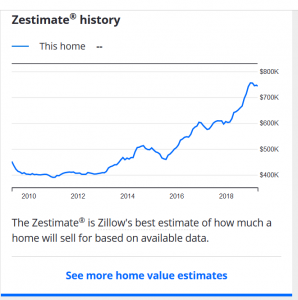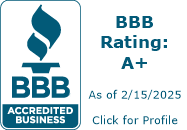
Recently zestimates have been on an upward trajectory, far outpacing typical gains in the market (the graph above shows a 50% increase in two years). Why is the zestimate suddenly increasing? Why is it increasing so rapidly? Is the zestimate really the market value? How does Zillow’s foray into buying and selling real estate play into the increases? How does sales price play into the new zestimate?
Zestimate increases
I look at hundreds of properties a year. The first step when evaluating a property is to type the address into google to see what comes up. More often than not Zillow comes up as one of the first search results. Over the last year I have seen the zestimate start to trend up substantially. Recently the zestimate has trended up beyond the true market value. For example, I was recently looking at a property in Copper Mountain, Colorado. The property was listed for 670k, the zestimate was 749.
How do I know the zestimate is being artificially inflated?
On every property I look at I always google the property to see what comes up, more often than not, the first return is Zillow. About a year ago I began noticing zestimates increasing faster than the market. Above is a graph of a property in Colorado that I was looking at. The property was listed for 529 in 2017, almost inline with the zestimate. The property was then taken off the market and relisted late 18 for 749. Ironically the zestimate increased almost 50% while the property still remains unsold.
This graph perplexed me; I started looking further at what this property is really worth. This particular property was a condo in the Colorado mountains. I pulled ever sale in the complex in the last 3 years. Every sale in the complex has been under 500k, with the same exact unit as this one that was updated selling for 450k 12 months ago. The zestimate is almost 70% higher than the actual market value of the property. This is not just a coincidence. I’ve seen this same trend occur on hundreds of properties in the last year or so as the zestimate provides greater weight to the sales price even if the sales price is radically different than the market value.
Why is the zestimate increasing?
Zillow will not provide an instant offer based on the zestimate
Before talking about why the zestimate is trending up, it is a bit ironic that Zillow places so much emphasis on the accuracy of their zestimate, yet do not provide an “instant offer” based on this number. According to Zillow: “We use the Zestimate as a starting point, then look at the information you provided about your home (current condition, recent updates) and the valuation of a local real estate agent. We factor in potential costs of renovations or repairs, and confirm or adjust our offer based on an in-person evaluation.”
Zillow through its instant offers is not putting its money where its mouth is! If the zestimate were a good valuation tool, why wouldn’t they use this number when buying houses? The real reason is that the zestimate is trending up.
- Zillow now in the real estate game
I can’t help but thinking that zillow’s recent entry into buying and selling real estate through instant offers has anything to do with it. Zillow recently has started buying and selling properties in Denver. I found five listings where Zillow had bought a house, did cosmetic rehabs and then relisted on the market. I’m sure it is no surprise, but in each listing the list price was less than the zestimate!
- Zillow got negative feedback from realtors and sellers
Zillow is in the data business selling ads, selling leads to realtors and mortgage professionals, and selling their own real estate now. If a zestimate comes in considerably less than the listing price of a house, how happy will that realtor be with Zillow? Ironically the zestimate is now factoring in the list price. If a house is listed with a high price the zestimate will increase. I’m not certain list prices should be given much weight in a fast moving market where prices can appreciate and depreciate quickly. Actual sales are a much better metric of value
- You can game your zestimate
Zillow now allows you to “update” your zestimate in other words you can now game the score. You can now go in and claim your house and update information like when you remodeled your house, square footage, beds, baths, other updates. This all sounds like a great idea but there is no way to know the accuracy of your information. For example, let’s say I put new garage doors on and feel that this classifies as remodeled. On the flip side, let’s say a house is a round dome house and you put the style as modern. It is modern, just not a desirable modern style. You can now see where this is heading. If you don’t believe me, I did this for my house changing the remodeled year, style, etc… and increased the zestimate over 20 percent! You can to
- No incentive to give a realistic number
Zillow has zero incentive to give a low number. Their goal to make customers the happiest is to provide a number that is realistic but at or above the list price of a property. Why would Zillow want to come in below what someone wants to list a property for? Why would Zillow want to make a zestimate lower than they are selling their own property for? The answer is simple, they wouldn’t which is why the zestimate continues to trend upwards.
Don’t trust your zestimate! Although your zestimate skyrocketed recently, the value of your house has likely just stayed the same over the last 12 months or so as the real estate market has cooled. Zillow has an incentive to ensure your zestimate is optimistic. On the flip side, Zillow has no zero incentive to ensure the accuracy of the zestimate as it would conflict with their revenue model. Your zestimate is now merely a marketing tool to further Zillow’s revenue model.
